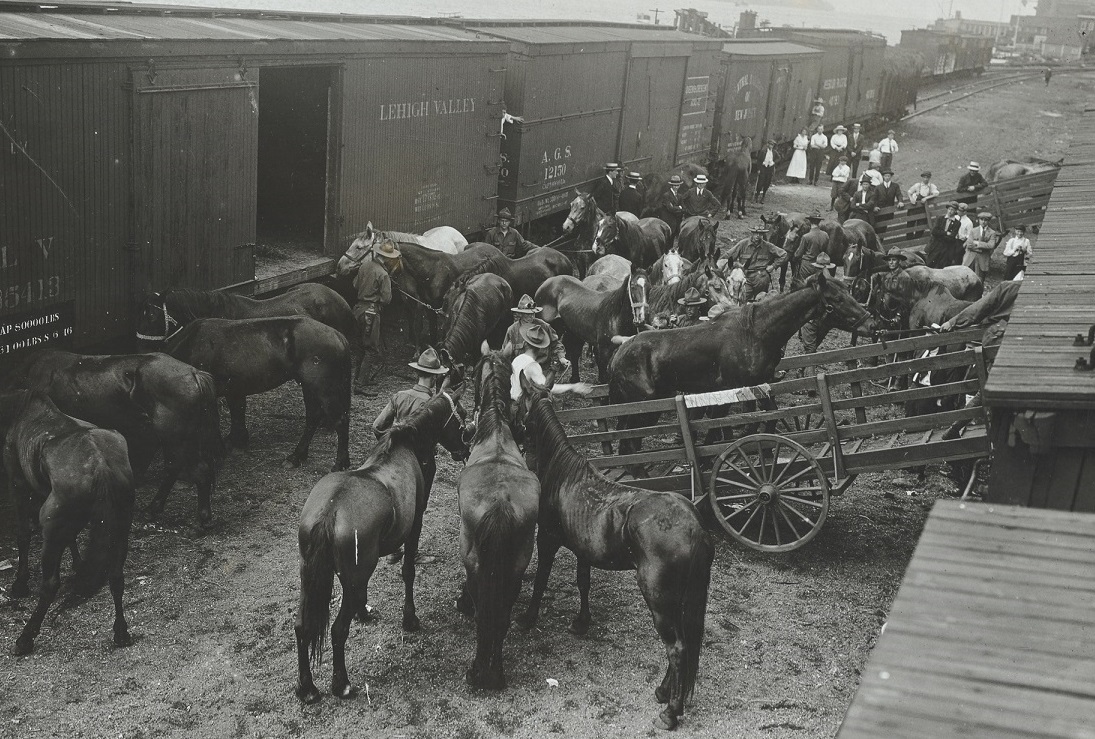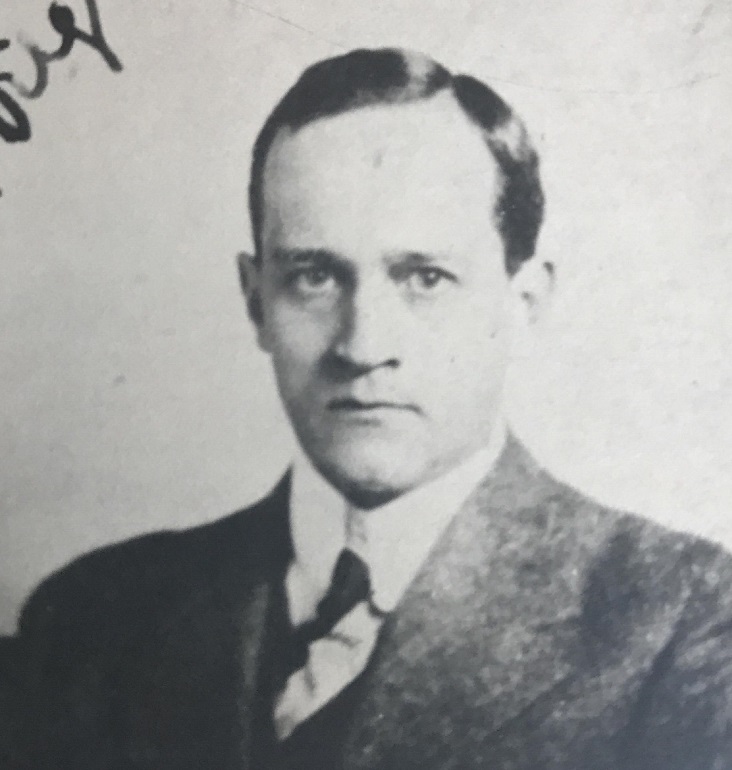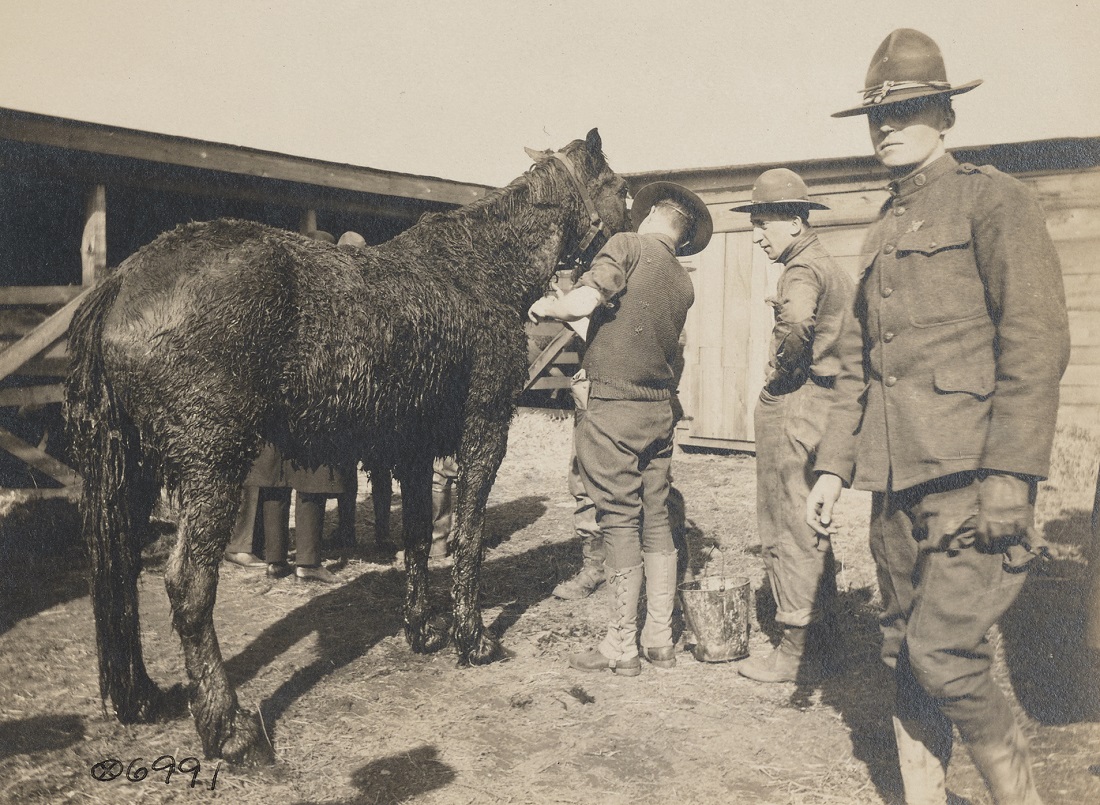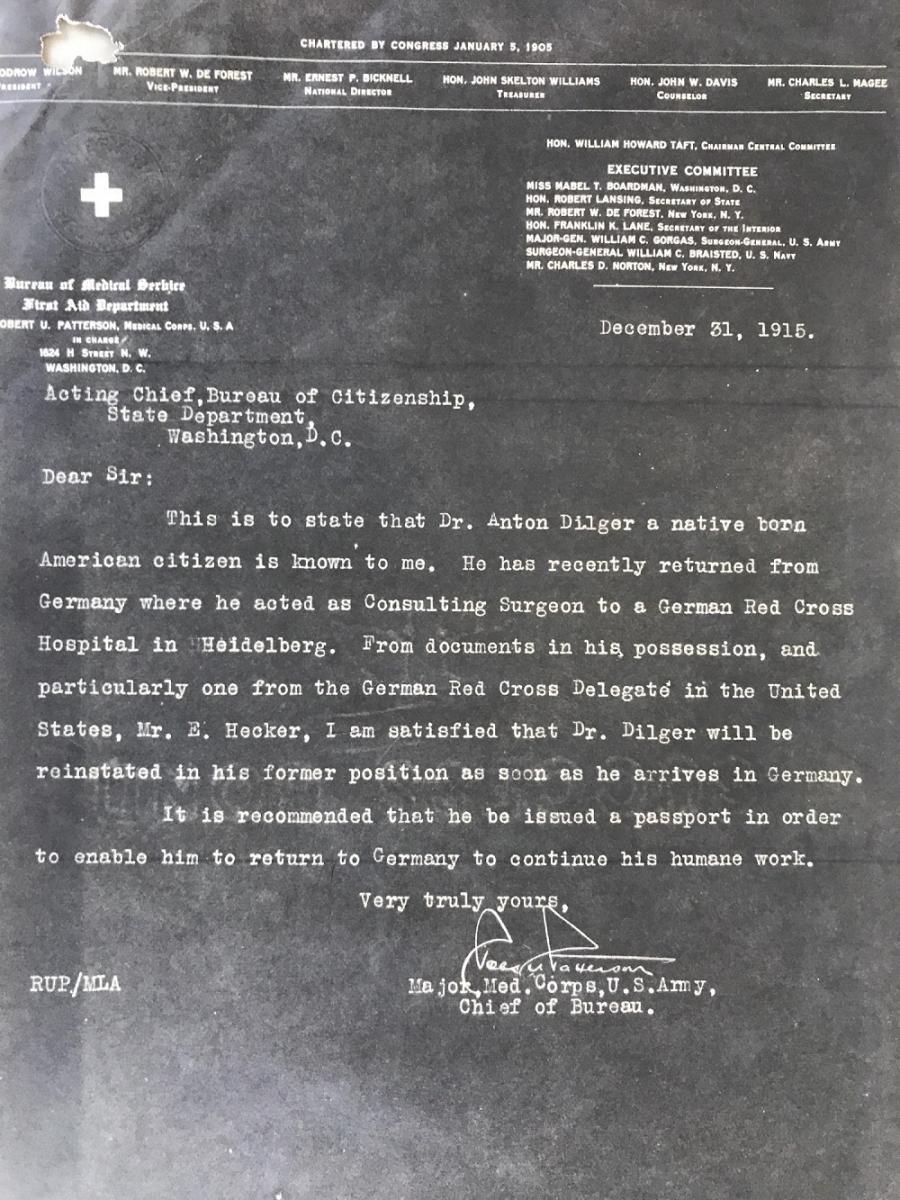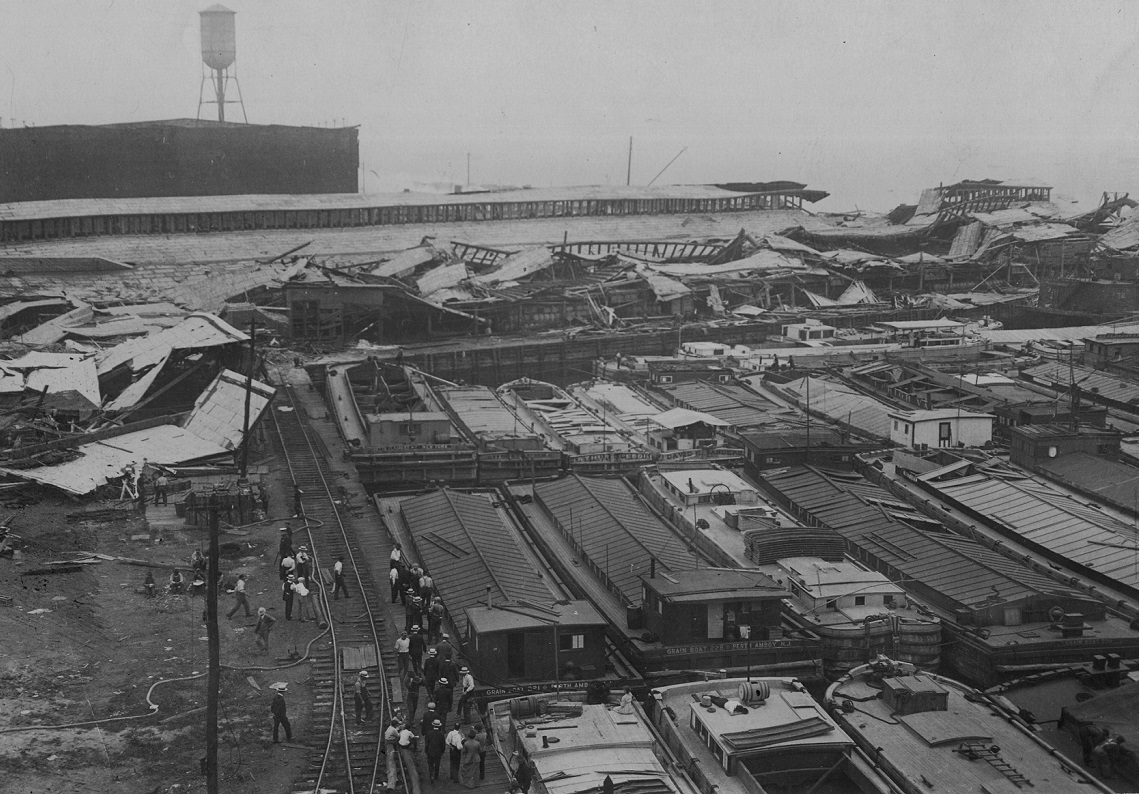
“Tony’s Lab”
Germ Warfare in WWI Used on Horses in the U.S.
Fall 2017, Vol. 49, No. 3
By David Pfeiffer
On a chilly November night in 1915, a dockhand crept silently through the darkness near the Newport News, Virginia, shipyard as he approached dockside corrals filled with horses destined to board British or French transport ships headed for Europe to aid in the Allied war effort.
As he neared the Breeze Point wharf, he carried a brown paper package and rubber gloves. He snapped on the gloves and removed from the package two glass syringes containing a yellow liquid.
The dockhand, a stevedore named John Grant, checked out the hundreds of horses and mules in the British remount depot. Taking care to avoid the night watchmen, he went to the first mule corral. Then he jabbed the needles into the hides of as many mules that he could reach. After jabbing many horses in two pens, he dumped the rest of the liquid in the animal’s water basins and food troughs and threw the gloves and syringes into the river.
During 1915–1916, thousands of horses and mules were killed in these horse pens. The yellow liquid, which carried the glanders bacteria, had been cooked up in what was known as “Tony’s Lab” by an American-born German agent named Anton Dilger.
German espionage and sabotage in the United States was going on long before the United States formally entered the war in April 1917. Dilger’s work was just one of many ways the Germans sought to undermine America’s ability to aid its allies. Fewer horses and mules would make moving artillery and other war materiel much more difficult; it had become a strategic priority for Germany.
Anton Dilger’s Early Life Spent Around Horses, Riding
Dilger was born on a horse farm, named Greenfield, near Front Royal, Virginia, on February 13, 1884. He was the son of Hubert Dilger, a German immigrant and a U.S. Army captain who had received the Medal of Honor for his service as a horse artillery officer at the Battle of Chancellorsville in the spring of 1863.
Hubert Dilger, an expert horseman, was instrumental in saving Union forces in the fighting retreat of General Hooker’s troops during Confederate General Stonewall Jackson’s flank attack at the end of the battle. The Confederates won the battle but did not destroy Hooker’s army, due partly to the efforts of Captain Dilger.
At Greenfield, Anton was taught to ride and to hunt and fish. He was also well acquainted with German culture. Four of his sisters married Germans and moved back to Germany. As a boy, Anton idolized his famous great grandfather on his mother’s side, Dr. Freidrich Tiedemann, known as the “great physiologist of Heidelberg.”
Anton’s grandfather was also a German medical doctor, so, unsurprisingly, Anton was sent, at the age of nine, to study in Germany. He stayed at his sister Edna’s house in Mannheim and enjoyed a comfortable life in Germany.
He passed the medical exam at the University of Heidelberg in 1908 and by 1909 was an assistant at the university surgical clinic while researching his doctoral dissertation. While studying microbiology and germ culture, he learned how to set up a tissue-culture lab. Ironically one of his challenges was how to prevent bacterial infections in animal tissue cultures. Later, in Washington, DC, he applied his expertise for the opposite purpose.
German Government Shows Interest in Dilger as Agent
Dilger received his doctoral degree in 1912, a year after Hubert Dilger died. Greenfield farm was in decline, and the family sold off part of the farm to the U.S. government. During the years before World War I, it became part of a U.S. Army Remount Depot, where the Army gathered, evaluated, and trained warhorses.
The young and handsome Doctor Dilger cemented his reputation back in Germany as a superb surgeon and a ladies man. Once war arrived, Dilger served in military hospitals performing battlefield surgery in Serbia and Bulgaria in 1914 and in Rastatt, Germany, in 1915. Seeing family members wounded and killed in the conflict hastened his conversion to a pro-German and anti-Allied outlook.
As a German patriot in possession of a U.S. passport, he was a prime candidate for recruitment by German intelligence to work in America.
According to German records, Dilger left Germany on September 29, 1915, working with the Imperial Prussian War Ministry in America.
Officially neutral, the United States provided loans and other goods and supplies to the Allies. Because America supplied hundreds of thousands of horses and mules to the war effort, the Prussian Imperial War Ministry was very interested in cutting off this supply.
Dilger, Brother, and Sister Leave Farm for Chevy Chase
Anton boarded the Dutch passenger liner Noordam in Amsterdam, bound for New York City and heading toward his final destination of Washington, DC. Among the items he carried was a small briefcase filled with fragile glass test tubes that contained the basis for manufacturing the glanders germ. The glanders bacteria was a primary killer of horses and mules.
With the help of his sister Jo, who lived with her family in northwest Washington, DC, he searched for a rental house where he could establish a physician’s office and set up a small laboratory for his experiments. He hung up his shingle but never saw any patients.
During a visit to Greenfield in December 1915, Anton persuaded his sister Em and his brother Carl to join him in Washington. He asked Em to be the housekeeper and Carl, a former beer brewer, to help in the lab. More importantly to Anton, she could be hostess and consequently discourage any possible gossip. Em had no idea that her brother was a German agent.
Carl had had his own brewery in Montana and knew how to propagate yeast and ferment vats of beer, a useful skill when it came to cooking up cultures. After Anton confided in him the nature of his mission, Carl was eager to help.
Anton settled in a two-story white brick house in the 5500 block of 33rd Street, NW, near Connecticut Avenue, not far from Chevy Chase Circle. Even in those days, Chevy Chase was a fast-growing and fashionable neighborhood, only six miles from the White House.
There was even a tramline connecting Chevy Chase with downtown. Because Chevy Chase was a new neighborhood with lots of strangers, Anton could easily blend in. Most important, the house had a spacious basement with a separate entrance that Anton could turn into a secret lab. It was a case of hiding in plain sight.
Anton Sets Up “Tony’s Lab”
Anton and Carl bought lab equipment and wire cages for the guinea pigs they would use to test the effectiveness of the poison they were to manufacture. They had an incubation oven, sterilizing machine, petri dishes and rows of glass vials. Later, Anton’s associates would call the basement “Tony’s Lab.”
For several months, the brothers incubated vials of anthrax and glanders. They were careful not to touch the cultures, since the bacteria in the cultures could also kill men. At room temperature, the cultures would be effective for about a month.
When the cultures were ready to go, German agents (Abeteilung IIB) from Baltimore stopped by the house each week to pick them up. These German agents then delivered the cultures to ports on the East Coast, including Newport News, Norfolk, Baltimore and New York, where hired stevedores would secretly inject the animals or contaminate their food supplies with the deadly germs.
The German agent who picked up the cultures at the little house on 33rd Street was Capt. Frederick Hinsch, one of the leaders of the Baltimore group of German agents. To demonstrate the effectiveness of the cultures, Anton showed him the guinea pigs; they were listless and dying. Hinsch was satisfied. In exchange for the cultures, Hinsch handed over a few thousand dollars to cover expenses, such as equipment, glassware purchases, house rental, and salaries for both Anton and Carl. The money came from Paul Hilken, the Baltimore paymaster.
The Baltimore group worked out of the offices of the North German Lloyd steamship line. Hinsch was charged with organizing dockhands, German sailors, and others for sabotage operations such as planting cigar bombs in U.S. ships carrying munitions, distributing flyers to get dockworkers to strike, and poisoning horses and mules being shipped to the Allies.
This was not the first German attempt at killing American horses. Agents earlier attempted to bomb or derail trains packed with horses or mules headed for British remount depots such as Newport News. In January 1915, the Germans planned to bomb transport trains in Canada that carried ammunition as well as warhorses. As it turned out, the cold Canadian winter made it difficult to lay the explosives.
New York City Police Increase Guards on Horses
After another plan to bomb trains heading out of the Chicago stockyards went awry, the Germans turned to germ warfare as a more efficient method to stem the supply of horses and mules heading to the Allies.
An attempt at germ warfare in May 1915 did not work because the saboteur, Erik von Steinmetz, did not know enough microbiology to keep the cultures alive. It became evident to the German General Staff that they had to have an agent who knew bacteriology and knew what he was doing. That agent was Dr. Anton Dilger.
The Dilgers continued to operate their lab until January 29, 1916, when Anton suddenly returned to Germany using a new U.S. passport he had obtained so he could, as he told the Department of State, work as a doctor in Heidelberg. He had also gotten a letter of recommendation from an acquaintance in the U.S. Army Medical Corps.
What had happened?
Capt. Tom Tunney was a New York City police detective and head of the department’s bomb squad assigned to investigate and apprehend the culprits in the bombing of buildings and ships in New York harbor. In the winter of 1915–1916, he gathered information concerning Steinmetz’s attempted germ attack and wondered if the Germans were going to make another attempt. He had no suspects and no clues—nothing but the fear of another attack.
Captain Tunney ordered doubling the guards at the New York horse corrals and spread the word along the waterfront to be on the lookout for enemy agents who might attempt to poison the animals. He later found out that his vigilance succeeded in preventing a large-scale biological attack.
At a secret meeting in late January 1916, Hilken, being somewhat cautious, told Hinsch and Dilger that “They’re on to us.” He had learned from Paul Koenig, a German agent in the New York area, that New York police were asking questions around the harbor about plots to poison horses awaiting shipment to the Allies. There were also more guards around the horse corrals. At the meeting, Dilger was handed a cable that ordered him back to Berlin “for discussions.” Anton had gotten his wish to get back to Germany, and Dilger’s lab had succeeded in remaining undetected.
U.S. Agents Interview Anton, Deem Him Not a Traitor
After Anton left, Carl Dilger continued the work of the lab with Fred Herrmann, a good friend of Anton’s, who had been living at the house. They added the manufacture of incendiary pencils and other explosives to their repertoire. Some of these incendiaries ended up being used in the Black Tom explosion in New Jersey, a munitions factory that supplied ammunition to the Allies
Because Carl tended to brag about his mission after having more than a couple of beers at the local taverns, Hilken and Hinsch pushed him out of the operation in May 1916. They sent him to Berlin with an important sealed message to the Political Section of the General Staff. The message was to keep Carl in Germany so that he could not undermine the sabotage operation in America, but the message was lost, and Carl continued in service delivering incendiary tubes. Herrman stayed on at the lab.
After the Black Tom explosion in July 1916 and the increased law enforcement scrutiny that followed, Herrmann decided to close up the lab and move to St. Louis. The St. Louis operation failed since Herrmann did not have Anton’s medical and scientific knowledge, and the germ cultures died.
Amazingly, it was the local police, like Captain Tunney in New York, not the national law enforcement entities such as the Bureau of Investigation, the Secret Service, and Military Intelligence, that were most effective against German sabotage operations. Bureaucratic inefficiencies, lack of law enforcement authority, and lack of staff contributed to their failure.
For example, an agent of the Bureau of Investigation interviewed Anton Dilger in July 1917 while he was visiting one of his brothers at Greenfield. He had come to America to deliver secret coded messages from Berlin to German agents and diplomats. Later in July, he was interviewed again by another bureau agent while he was staying at his sister Jo’s house in Washington. Again, this interview did not raise any red flags, the agent saying in his report that “Dr. Dilger is not a man who would be guilty of any traitorous acts towards this country.” Anton Dilger had slipped through the bureau’s fingers.
Anton Receives Iron Cross for His Service to Germany
Anton then went to Mexico to join with the other Baltimore-based agents, specifically Hinsch and Hilken, who had escaped the United States after the declaration of war in April 1917. Taking on the alias “Dr. Delmar,” Anton’s main mission from Berlin was to promote a Mexican invasion of the United States, and he raised money to finance the proposed campaign. Feuding among Anton, the German agents, and Berlin caused the campaign to fizzle, but Anton was still awarded the Iron Cross in January 1918 in recognition of his sabotage and espionage work.
Even so, Anton had made enemies both in Mexico and Berlin. Now in Spain, he feared that Allied investigators were finally catching up to him. Then came the Spanish influenza epidemic of 1918–1919, which killed possibly as many as 50 million people worldwide. On October 17, 1918, Anton Dilger died of influenza in Madrid at the age of 34. That was the official story. Ironically, he was a germ saboteur killed by an infectious disease.
There were problems with this version of events. Carl Dilger and Fred Herrmann later claimed that they suspected German agents had murdered Anton—that he had been poisoned “because he knew too much.” In testimony years later to the Mixed Claims Commission, they alleged that Anton’s cover had been blown and Allied agents were closing in. There is still some doubt whether Anton even died in Madrid in 1918. The details of his death remain murky to this day.
The Mixed Claims Commission, U.S. and Germany, was established in 1922 for the purpose of satisfying claims of the United States and its citizens against Germany since 1914. By 1933, most of the claims had been settled. The largest group of unsettled claims were the sabotage claims, which consisted of the 153 claims of U.S. citizens who suffered losses as a result of German sabotage in 1916–1917. The sabotage claims remained before the commission for more than 12 years, and due to German intransigence, it was not until 1939 that a decision was rendered in favor of the U.S. claimants.
According to later estimates, the German germ sabotage campaign in America killed thousands of horses during World War I. Even so, that number was not a significant factor in the war effort since more than over 750,000 horses were shipped to the Allies from America. This was the first modern germ warfare campaign in history. But it was not the last.
The story of Anton Dilger and “Tony’s Lab” are filled with ironies. But the most notable one is that an American-born son of a Civil War hero, who loved horses and was an expert horseman, became a German agent whose germ cultures were responsible for the deaths of thousands of horses in the United States during World War I.
David A. Pfeiffer retired earlier this year after 40 years as an archivist at the National Archives, specializing in transportation and diplomatic records. Over the years, he has written a number of articles for Prologue, including the award-winning “Bridging the Mississippi: The Railroads and Steamboats Clash at the Rock Island Bridge” in Summer 2004. He holds a bachelor’s degree from Ithaca College and a master’s degree from George Mason University, both in history.
Note on Sources
The main primary source that I consulted was the records of the Mixed Claims Commission, United States and Germany, 1922–1941. The records are part of Record Group 76: Records of Boundary and Claims Commissions and Arbitrations housed at the National Archives at College Park in Maryland. The MCC records include a tremendous amount of information on the sabotage claims cases and their eventual settlement. The record series consulted for this article were the Records Relating to German Saboteurs and Their Activities, Chronological List of German Sabotage Activities, 1893–1927 (Entry 73), which has a great chronology of the surveillance of German agents, and the Records Relating to German Saboteurs (Entry 76). There are files on Anton and Carl Dilger, Frederick Herrmann, Paul Hilken, and Frederick Hinsch, and others. I also briefly checked the Testimony of Frederick L Herrmann and Theodore J. Wozniak, 1930 (Entry 79) and Testimony in Sabotage Cases, 1930 (Entry 82).
There are two agent reports on interviews with Anton Dilger during July 1917 in the Records of the Federal Bureau of Investigation (Record Group 65), Investigative Cases Files of the Bureau, 1908–1922 (Microfilm Publication M1085), Old German Files #33415 and #26601. These records are also at the National Archives at College Park.
My main secondary source was The Fourth Horseman: One Man’s Mission to Wage the Great War in America, by Robert Koenig. This is the definitive work on Anton Dilger, and the author pieced together a great story of Dilger and World War I German sabotage. As he mentioned in his note to sources, there are many gaps in the records and his personal letters. And espionage is not usually well documented.
Other books consulted include the classic on German espionage, particularly Black Tom and Kingsland, by Jules Witcover titled Sabotage at Black Tom: Imperial Germany’s Secret War in America, 1914–1917. See also The Secret War on the United States in 1915: A Tale of Sabotage, Labor Unrest and Border Troubles, by Heribert von Feilistzsch; The Detonators: The Secret Plot to Destroy America and an Epic Hunt for Justice, by Chad Millman; and the Dark Invasion, 1915, Germany’s Secret War and the Hunt for the First Terrorist Cell in America, by Howard Blum. There is also a very good post in the WETA Boundary Stones blog, by Mark Jones titled “‘Tony’s Lab’ and World War I Germ Sabotage in Washington.”
I also consulted a book review on the Fourth Horseman by Jack Woodall titled “Bioterror Is Nothing New.” And finally, I looked at a piece by Sarah McCammon of NPR on April 6, 2017, called “The Unsung Equestrian Heroes of World War I and the Plot to Poison Them” (www.npr.org/2017/04/06/522594344/the-unsung-equestrian-heroes-of-world-war-i-and-the-plot-to-poison-them)
